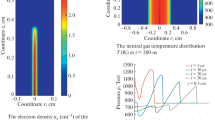Abstract
The formation times of self-sustained subnanosecond discharges in nitrogen at pressures of 1‒40 atm and in hydrogen at pressures of 1–60 atm are analyzed in terms of the avalanche model. In experiments, a subnanosecond voltage pulse with an amplitude of 102 ± 2 kV was applied to a 0.5-mm-long discharge gap with a uniformly distributed electric field (the curvature radii of both the cathode and anode ends were 1 cm). The rise time of the voltage pulse from 0.1 to 0.9 of its amplitude value was about 250 ps. Breakdown occurred at the leading edge of the pulse. The discharge formation time was measured at different gas pressures with a step of 5–10 atm. Analysis of the experimental results shows that, in nitrogen at pressures of 10–40 atm and in hydrogen at pressures of 20–50 atm, breakdown occurs earlier than the electron avalanche reaches its critical length and that the critical avalanche length lies in the range of (2–8) × 10–2 mm, which is one order of magnitude shorter than the discharge gap length. This means that the avalanche–streamer model is inapplicable in this case. The fast formation of a conducting channel under these conditions can be explained by ionization of gas by runaway electrons. In this case, the conducting column develops as a result of simultaneous development of a large number of electron avalanches in the gas volume. An increase in the hydrogen pressure from 50 to 60 atm leads to an abrupt increase in the discharge formation time by about 50%. As a result, the growth time of the electron avalanche to its critical length becomes shorter than the discharge formation time. In this case, the electrons cease to pass into the runaway regime and the discharge is initiated from the cathode due to field emission from microinhomogeneities on its surface. Under these conditions, the discharge formation time is well described by the avalanche–streamer model.
Similar content being viewed by others
References
Yu. D. Korolev and G. A. Mesyats, Physics of Pulsed Gas Breakdown (Nauka, Moscow, 1991) [in Russian].
Electrical Breakdown of Gases, Ed. by J. M. Meek and J. D. Craggs (Wiley, New York, 1978).
G. A. Mesyats, Yu. I. Bychkov, and V. V. Kremnev, Sov. Phys. Usp. 15, 282 (1972).
R. C. Fletcher, Phys. Rev. 76, 1501 (1949).
P. Felsenthal and J. M. Proud, Phys. Rev. 139, A1796 (1965).
G. A. Mesyats, Yu. I. Bychkov, and A. M. Iskol’dskii, Sov. Phys. Tech. Phys. 13, 1051 (1968).
V. F. Tarasenko, D. V. Beloplotov, and M. I. Lomaev, Plasma Phys. Rep. 41, 832 (2015).
Yu. D. Korolev and N. M. Bykov, IEEE Trans. Plasma Sci. 40, 2443 (2012).
Yu. D. Korolev, N. M. Bykov, and S. N. Ivanov, Plasma Phys. Rep. 34, 1022 (2008).
S. N. Ivanov, E. A. Litvinov, and V. G. Shpak, Tech. Phys. Lett. 32, 745 (2006).
S. N. Ivanov and K. A. Sharypov, Tech. Phys. Lett. 42, 274 (2016).
S. N. Ivanov and K. A. Sharypov, Izv. Vyssh. Uchebn. Zaved., Fizika 57 (12/2), 186 (2014).
S. N. Ivanov and K. A. Sharypov, Izv. Vyssh. Uchebn. Zaved., Fizika 58 (12/2), 137 (2015).
S. N. Ivanov and K. A. Sharypov, Tech. Phys. 60, 1478 (2015).
M. I. Yalandin and V. G. Shpak, Instrum. Exp. Tech. 44, 285 (2001).
A. N. Dyad’kov, S. N. Ivanov, and M. R. Ul’maskulov, Instrum. Exp. Tech. 41, 358 (1998).
H. Raether, Electron Avalanches and Breakdown in Gases (Butterworths, London, 1964).
A. M. Efremov, B. M. Koval’chuk, and Yu. D. Korolev, Tech. Phys. 57, 478 (2012).
V. L. Granovskii, Electrical Current in Gas: Steady-State Current (Nauka, Moscow, 1971) [in Russian].
Yu. P. Raizer, Gas Discharge Physics (Nauka, Moscow, 1992; Springer, Berlin, 1997).
Yu. D. Korolev and G. A. Mesyats, Field-Emission and Explosive Processes in Gas Discharges (Nauka, Novosibirsk, 1982) [in Russian].
S. N. Ivanov, J. Phys. D 46, 285201 (2013).
S. N. Ivanov and V. V. Lisenkov, Tech. Phys. 55, 53 (2010).
S. N. Ivanov, V. V. Lisenkov, and V. G. Shpak, Tech. Phys. 53, 1162 (2008).
S. N. Ivanov, V. V. Lisenkov, and V. G. Shpak, J. Phys. D 43, 315204 (2010).
S. N. Ivanov, Phys. Doklady 49, 701 (2004).
V. V. Lisenkov and V. A. Shklyaev, Tech. Phys. 59, 1780 (2014).
V. V. Lisenkov and V. A. Shklyaev, Phys. Plasmas 22, 113507 (2015).
Author information
Authors and Affiliations
Corresponding author
Additional information
Original Russian Text © S.N. Ivanov, V.V. Lisenkov, 2018, published in Fizika Plazmy, 2018, Vol. 44, No. 3, pp. 323–332.
Rights and permissions
About this article
Cite this article
Ivanov, S.N., Lisenkov, V.V. Study of the Formation Time of a Self-Sustained Subnanosecond Discharge at High and Ultrahigh Gas Pressures. Plasma Phys. Rep. 44, 369–377 (2018). https://doi.org/10.1134/S1063780X18030042
Received:
Accepted:
Published:
Issue Date:
DOI: https://doi.org/10.1134/S1063780X18030042



